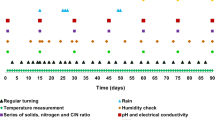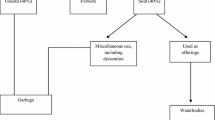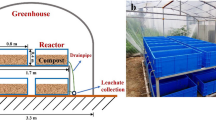Abstract
Floral waste (FW) forms the most overlooked part of municipal solid waste (MSW) in India and is one of the major sources of water pollution due to the traditional method of disposing of the FW. The current study focuses on the characterization of FW samples based on proximate, ultimate, elemental, morphological, and biochemical analyses. The samples had moisture content (MC) ranging from 6.1 to 12.86%, whereas volatile matter (VM) and ash content (AC) were in the range of 79.99–88.68% and 4.35–9.79%, respectively. NPK values and elemental analysis suggest that the FW samples are also promising feedstock for compost production without any adverse effect on the environment. However, FW samples were found to be acidic in nature (3.88–5.47) with a variable C/N ratio, ranging from 11.82 to 38.26. Morphological studies show that the FW samples have heterogeneous surfaces. FW samples were also found to be high in cellulose (22.31–37.22%) and hemicellulose (19.19–38.89%) content and low in lignin content (1.76–4.54%). Stoichiometric methane potential (SMP) and stoichiometric ethanol potential (SEP) of FW were calculated based on the ultimate and biochemical analyses, respectively of FW. SMP was found to be in the range of 0.170–0.434 L CH4 g−1 VS, whereas SEP was found in the range of 0.433–0.582 Lg−1. The results exhibit that FW can be used as a potential candidate for bioenergy and compost production.



Similar content being viewed by others
Data availability
All data generated during this study are included in this manuscript.
Abbreviations
- FW:
-
Floral waste
- MSW:
-
Municipal solid waste
- MC:
-
Moisture content
- VM:
-
Volatile matter
- AC:
-
Ash content
- SMP:
-
Stoichiometric methane potential
- SEP:
-
Stoichiometric ethanol potential
- LCB:
-
Lignocellulosic biomass
- FC:
-
Fixed carbon
- HR:
-
Hibiscus
- OM:
-
Orange marigold
- YM:
-
Yellow marigold
- PA:
-
Frangipani
- WK:
-
White kaner
- PR:
-
Pink rose
- RR:
-
Red rose
- YC:
-
Yellow chrysanthemum
- OC:
-
Orange chrysanthemum
- CJ:
-
Crepe jasmine
- SL:
-
Spider lily
- HHV:
-
Higher heating value
- SEM:
-
Scanning electron microscope
- NDF:
-
Neutral detergent fiber
- ADF:
-
Acid detergent fiber
- ADL:
-
Acid detergent lignin
- VS:
-
Volatile solids
- ICP-OES:
-
Inductively coupled plasma–optical emission spectrophotometer
- ND:
-
Not detected
References
Yusuf AA, Inambao FL (2019) Bioethanol production from different Matooke peels species: a surprising source for alternative fuel. Case Stud Therm Eng 13:100357. https://doi.org/10.1016/j.csite.2018.11.008
Barampouti EM, Mai S, Moustakas K et al (2021) CHAPTER 3 - Status and perspectives of agricultural residues in a circular and resource-efficient context. In: Tyagi V, Aboudi KBT-CE and RR (eds) Clean energy and resources recovery. Elsevier, pp 49–102
Panigrahi S, Dubey BK (2019) A critical review on operating parameters and strategies to improve the biogas yield from anaerobic digestion of organic fraction of municipal solid waste. Renew Energy 143:779–797. https://doi.org/10.1016/J.RENENE.2019.05.040
Sarsaiya S, Jain A, Kumar Awasthi S et al (2019) Microbial dynamics for lignocellulosic waste bioconversion and its importance with modern circular economy, challenges and future perspectives. Bioresour Technol 291:121905. https://doi.org/10.1016/j.biortech.2019.121905
Kumar V, Kumari S, Kumar P (2020) Management and sustainable energy production using flower waste generated from temples. Environ Degrad Causes Remediat Strateg 154–165. https://doi.org/10.26832/aesa-2020-edcrs-011
Dutta S, Kumar MS (2021) Potential of value-added chemicals extracted from floral waste: a review. J Clean Prod 294:126280. https://doi.org/10.1016/j.jclepro.2021.126280
Nguyen DTC, Le HTN, Nguyen TT et al (2021) Engineering conversion of Asteraceae plants into biochars for exploring potential applications: a review. Sci Total Environ 797:149195. https://doi.org/10.1016/j.scitotenv.2021.149195
Sharma D, Yadav KD, Kumar S (2018) Role of sawdust and cow dung on compost maturity during rotary drum composting of flower waste. Bioresour Technol 264:285–289. https://doi.org/10.1016/j.biortech.2018.05.091
Sharma D, Yadav KD, Kumar S (2018) Biotransformation of flower waste composting: optimization of waste combinations using response surface methodology. Bioresour Technol 270:198–207. https://doi.org/10.1016/j.biortech.2018.09.036
Mozhiarasi V, Speier CJ, Rose PMB et al (2019) Variations in generation of vegetable, fruit and flower market waste and effects on biogas production, exergy and energy contents. J Mater Cycles Waste Manag 21:713–728. https://doi.org/10.1007/s10163-019-00828-2
Raghu S (2019) A holy mess. In: New Indian Express, https://www.newindianexpress.com/magazine/2019/jul/07/a-holy-mess-1999557.html. Accessed 20 Aug 2021
Samadhiya H, Pradesh M, Pradesh M (2017) Disposal and management of temple waste: current status and possibility of vermicomposting. Int J Adv Res Dev 2:359–366
Aich A, Ghosh SK (2019) Conceptual framework for municipal solid waste processing and disposal system in India. In: Ghosh S (ed) Waste management and resource efficiency. Springer Singapore. https://doi.org/10.1007/978-981-10-7290-1_9
Desai K (2018) How these temples give a new life to old flowers. In: The Times of India. https://timesofindia.indiatimes.com/india/how-these-temples-give-a-new-life-to-old-flowers/articleshow/65762167.cms. Accessed 15 Aug 2021
Das D (2018) Red roses at Ajmer Dargah will be now converted to organic compost. In: Life Beyond Numbers. https://lifebeyondnumbers.com/red-roses-at-ajmer-dargah-will-be-now-converted-to-organic-compost/. Accessed 15 Aug 2021
Perumal K, Moorthy S, Savitha JS (2012) Characterization of essential oil from offered temple flower Rosa damascena mill. Asian J Exp Biol Sci 3:330–334
Goswami S (2018) In these temples, offerings do not go waste. In: Down To Earth. https://www.downtoearth.org.in/news/waste/in-these-temples-offerings-do-not-go-waste-60758. Accessed 6 Aug 2021
Solanke A, Wadar S, Telang S et al (2018) Study of Nirmalya solid waste treatment by artificial and natural aeration vermicomposting. Int J Sci Res Dev 6:296–300
Vankar PS, Shanker R, Wijayapala S (2009) Utilization of temple waste flower Tagetus erecta for dyeing of cotton, wool and silk on industrial scale. J Text Apparel Technol Manag 6:1–15
Pervaiz S, Mughal TA, Khan FZ et al (2017) Environmental friendly leather dyeing using Tagetes erecta L. (Marigold) waste flowers. Int J Biosci 10:382–390. https://doi.org/10.12692/ijb/10.1.382-390
Adlakha N (2018) Recycling temple waste along the Ganges with Help Us Green. In: The Hindu. https://www.thehindu.com/life-and-style/the-worlds-first-biodegradable-thermocol-and-flower-leather-by-ankit-agarwals-kanpur-based-organisation-help-us-green/article25013953.ece. Accessed 16 Aug 2021
Nguyen DTC, Nguyen TT, Le HTN et al (2021) The sunflower plant family for bioenergy, environmental remediation, nanotechnology, medicine, food and agriculture: a review. Environ Chem Lett 19:3701–3726. https://doi.org/10.1007/s10311-021-01266-z
Yusuf AA, Inambao FL (2019) Bioethanol production techniques from lignocellulosic biomass as alternative fuel: a review. Int J Adv Res Eng Technol 10:259–288
Moreno AD, Magdalena JA, Oliva JM et al (2021) Sequential bioethanol and methane production from municipal solid waste: an integrated biorefinery strategy towards cost-effectiveness. Process Saf Environ Prot 146:424–431. https://doi.org/10.1016/j.psep.2020.09.022
Shahbaz M, Ammar M, Zou D et al (2019) An insight into the anaerobic co-digestion of municipal solid waste and food waste: influence of co-substrate mixture ratio and substrate to inoculum ratio on biogas production. Appl Biochem Biotechnol 187:1356–1370. https://doi.org/10.1007/s12010-018-2891-3
Gómez X, Cuetos MJ, Cara J et al (2006) Anaerobic co-digestion of primary sludge and the fruit and vegetable fraction of the municipal solid wastes: conditions for mixing and evaluation of the organic loading rate. Renew Energy 31:2017–2024. https://doi.org/10.1016/j.renene.2005.09.029
Zhu H, Parker W, Conidi D et al (2011) Eliminating methanogenic activity in hydrogen reactor to improve biogas production in a two-stage anaerobic digestion process co-digesting municipal food waste and sewage sludge. Bioresour Technol 102:7086–7092. https://doi.org/10.1016/j.biortech.2011.04.047
American Society for Testing and Materials (2015) ASTM E1756 - 08: Standard test method for determination of total solids in biomass. In: Annual Book of ASTM Standards. ASTM International, Philadelphia, PA
American Society for Testing and Materials (2007) ASTM E1755–01: Standard test method for ash in biomass. In: Annual Book of ASTM Standards. ASTM International, Philadelphia, PA
American Society for Testing and Materials (2019) ASTM E872–82: Standard test method for volatile matter in the analysis of particulate wood fuels. In: Annual Book of ASTM Standards. ASTM International, Philadelphia, PA
Singh YD, Mahanta P, Bora U (2017) Comprehensive characterization of lignocellulosic biomass through proximate, ultimate and compositional analysis for bioenergy production. Renew Energy 103:490–500. https://doi.org/10.1016/j.renene.2016.11.039
United States Environmental Protection Agency (2004) USEPA Method 9045D: Soil and Waste pH. 1–5. https://www.epa.gov/sites/default/files/2015-12/documents/9045d.pdf
American Society for Testing and Materials (2009) ASTM D5198–09: standard practice for nitric acid digestion of solid waste. In: Annual Book of ASTM Standards. ASTM International, Philadelphia, PA
Goering HK, Van Soest PJ (1970) Forage fiber analysis (apparatus, reagents, procedures, and some applications). In: Agriculture Handbook No. 379. Agricultural Research Service, United States Department of Agriculture, Washington, DC
Lowry OH, Rosebrough NJ, Farr AL, Randall RJ (1951) Protein measurement with the folin phenol reagent. J Biol Chem 193:265–275. https://doi.org/10.1016/S0021-9258(19)52451-6
Hedge JE, Hofreiter BT (1962) Estimation of carbohydrate. In: Carbohydrate chemistry. Academic Press, New York
American Public Health Association (2012) APHA 2540-G. In: Standard methods for the examination of water and wastewater, 22nd ed. American Public Health Association, Washington, DC
Choudhary P, Prajapati SK, Malik A (2016) Screening native microalgal consortia for biomass production and nutrient removal from rural wastewaters for bioenergy applications. Ecol Eng 91:221–230. https://doi.org/10.1016/j.ecoleng.2015.11.056
Pattanaik L, Naik SN, Hariprasad P (2019) Valorization of waste Indigofera tinctoria L. biomass generated from indigo dye extraction process—potential towards biofuels and compost. Biomass Convers Biorefinery 9:445–457. https://doi.org/10.1007/s13399-018-0354-2
Oyedun AO, Tee CZ, Hanson S, Hui CW (2014) Thermogravimetric analysis of the pyrolysis characteristics and kinetics of plastics and biomass blends. Fuel Process Technol 128:471–481. https://doi.org/10.1016/j.fuproc.2014.08.010
García R, Pizarro C, Lavín AG, Bueno JL (2012) Characterization of Spanish biomass wastes for energy use. Bioresour Technol 103:249–258. https://doi.org/10.1016/j.biortech.2011.10.004
Vassilev SV, Baxter D, Andersen LK, Vassileva CG (2010) An overview of the chemical composition of biomass. Fuel 89:913–933. https://doi.org/10.1016/j.fuel.2009.10.022
Yusuf AA, Inambao FL (2020) Characterization of Ugandan biomass wastes as the potential candidates towards bioenergy production. Renew Sustain Energy Rev 117:109477. https://doi.org/10.1016/j.rser.2019.109477
Ahmed A, Hidayat S, Abu Bakar MS et al (2021) Thermochemical characterisation of Acacia auriculiformis tree parts via proximate, ultimate, TGA, DTG, calorific value and FTIR spectroscopy analyses to evaluate their potential as a biofuel resource. Biofuels 12:9–20. https://doi.org/10.1080/17597269.2018.1442663
Olupot PW, Candia A, Menya E, Walozi R (2016) Characterization of rice husk varieties in Uganda for biofuels and their techno-economic feasibility in gasification. Chem Eng Res Des 107:63–72. https://doi.org/10.1016/j.cherd.2015.11.010
Van Hung N, Maguyon-Detras MC, Migo MV et al (2020) Rice straw overview: availability, properties, and management practices BT - sustainable rice straw management. In: Van HN, Chivenge P, Douthwaite B (eds) Gummert M. Springer International Publishing, Cham, pp 1–13
Akwu NA, Naidoo Y, Singh M (2019) A comparative study of the proximate, FTIR analysis and mineral elements of the leaves and stem bark oF Grewia lasiocarpa E.Mey. ex Harv.: an indigenous southern African plant. South African J Bot 123:9–19. https://doi.org/10.1016/j.sajb.2019.01.028
Singh A, Jain A, Sarma BK et al (2013) Solid waste management of temple floral offerings by vermicomposting using Eisenia fetida. Waste Manag 33:1113–1118. https://doi.org/10.1016/j.wasman.2013.01.022
Sharma D, Yadav KD (2018) Application of rotary in-vessel composting and analytical hierarchy process for the selection of a suitable combination of flower waste. Geol Ecol Landscapes 9508:1–11. https://doi.org/10.1080/24749508.2018.1456851
Sharma D, Yadav KD (2017) Bioconversion of flowers waste : composting using dry leaves as bulking agent. Environ Eng Res 22:237–244
Swain MR, Kar S, Sahoo AK, Ray RC (2007) Ethanol fermentation of mahula (Madhuca latifolia L.) flowers using free and immobilized yeast Saccharomyces cerevisiae. Microbiol Res 162:93–98. https://doi.org/10.1016/j.micres.2006.01.009
Lay J-J, Li Y-Y, Noike T (1997) Influences of pH and moisture content on the methane production in high-solids sludge digestion. Water Res 31:1518–1524. https://doi.org/10.1016/S0043-1354(96)00413-7
Kwoczynski Z, Čmelík J (2021) Characterization of biomass wastes and its possibility of agriculture utilization due to biochar production by torrefaction process. J Clean Prod 280:124302. https://doi.org/10.1016/j.jclepro.2020.124302
Parikh J, Channiwala SA, Ghosal GK (2007) A correlation for calculating elemental composition from proximate analysis of biomass materials. Fuel 86:1710–1719. https://doi.org/10.1016/j.fuel.2006.12.029
Abdul Samad NAF, Jamin NA, Saleh S (2017) Torrefaction of municipal solid waste in Malaysia. Energy Procedia 138:313–318. https://doi.org/10.1016/j.egypro.2017.10.106
Baawain M, Al-Mamun A, Omidvarborna H, Al-Amri W (2017) Ultimate composition analysis of municipal solid waste in Muscat. J Clean Prod 148:355–362. https://doi.org/10.1016/j.jclepro.2017.02.013
Voca N, Grubor M, Peter A, Kricka T (2019) Evaluation of Posidonia oceanica waste as a biomass source for energy generation. BioEnergy Res 12:1104–1112. https://doi.org/10.1007/s12155-019-10032-7
Mishra RK, Mohanty K (2018) Characterization of non-edible lignocellulosic biomass in terms of their candidacy towards alternative renewable fuels. Biomass Convers Biorefinery 8:799–812. https://doi.org/10.1007/s13399-018-0332-8
Pas C, P. S, (2021) Correlation between empirical formulae based stoichiometric and experimental methane potential and calorific energy values for vegetable solid wastes. Energy Rep 7:19–31. https://doi.org/10.1016/j.egyr.2020.10.071
Channiwala SA, Parikh PP (2002) A unified correlation for estimating HHV of solid, liquid and gaseous fuels. Fuel 81:1051–1063. https://doi.org/10.1016/S0016-2361(01)00131-4
Nguyen V-T, Le T-H, Bui X-T et al (2020) Effects of C/N ratios and turning frequencies on the composting process of food waste and dry leaves. Bioresour Technol Rep 11:100527. https://doi.org/10.1016/j.biteb.2020.100527
Barik D (2019) Chapter 3 - Energy extraction from toxic waste originating from food processing industries. In: Barik DBT-E from TOW for H and PG (ed) Woodhead Publishing Series in Energy. Woodhead Publishing, pp 17–42
Kauser H, Pal S, Haq I, Khwairakpam M (2020) Evaluation of rotary drum composting for the management of invasive weed Mikania micrantha Kunth and its toxicity assessment. Bioresour Technol 313:123678. https://doi.org/10.1016/j.biortech.2020.123678
Zhu N (2007) Effect of low initial C/N ratio on aerobic composting of swine manure with rice straw. Bioresour Technol 98:9–13. https://doi.org/10.1016/j.biortech.2005.12.003
Kumar M, Ou Y-L, Lin J-G (2010) Co-composting of green waste and food waste at low C/N ratio. Waste Manag 30:602–609. https://doi.org/10.1016/j.wasman.2009.11.023
Huang GF, Wong JWC, Wu QT, Nagar BB (2004) Effect of C/N on composting of pig manure with sawdust. Waste Manag 24:805–813. https://doi.org/10.1016/j.wasman.2004.03.011
Yusuf AA, Inambao FL, Hassan AS et al (2020) Comparative study on pyrolysis and combustion behavior of untreated Matooke biomass wastes in East Africa via TGA, SEM, and EDXS. Int J Energy Environ Eng 11:265–273. https://doi.org/10.1007/s40095-019-00331-2
Leng L, Leng S, Chen J et al (2018) The migration and transformation behavior of heavy metals during co-liquefaction of municipal sewage sludge and lignocellulosic biomass. Bioresour Technol 259:156–163. https://doi.org/10.1016/j.biortech.2018.03.019
Saidur R, Abdelaziz EA, Demirbas A et al (2011) A review on biomass as a fuel for boilers. Renew Sustain Energy Rev 15:2262–2289. https://doi.org/10.1016/j.rser.2011.02.015
Bhattacharyya P, Bhaduri D, Adak T et al (2020) Characterization of rice straw from major cultivars for best alternative industrial uses to cutoff the menace of straw burning. Ind Crops Prod 143:111919. https://doi.org/10.1016/j.indcrop.2019.111919
Hameed Z, Aslam M, Khan Z et al (2021) Gasification of municipal solid waste blends with biomass for energy production and resources recovery: current status, hybrid technologies and innovative prospects. Renew Sustain Energy Rev 136:110375. https://doi.org/10.1016/j.rser.2020.110375
Prasad RK, Chatterjee S, Mazumder PB et al (2019) Bioethanol production from waste lignocelluloses: a review on microbial degradation potential. Chemosphere 231:588–606. https://doi.org/10.1016/j.chemosphere.2019.05.142
Cheng JJ, Timilsina GR (2011) Status and barriers of advanced biofuel technologies: a review. Renew Energy 36:3541–3549. https://doi.org/10.1016/j.renene.2011.04.031
Aramrueang N, Zicari SM, Zhang R (2017) Characterization and compositional analysis of agricultural crops and residues for ethanol production in California. Biomass Bioenerg 105:288–297. https://doi.org/10.1016/j.biombioe.2017.07.013
Sasmal S, Goud VV, Mohanty K (2012) Characterization of biomasses available in the region of North-East India for production of biofuels. Biomass Bioenerg 45:212–220. https://doi.org/10.1016/j.biombioe.2012.06.008
Gabhane J, Prince William SPM, Gadhe A et al (2014) Pretreatment of banana agricultural waste for bio-ethanol production: individual and interactive effects of acid and alkali pretreatments with autoclaving, microwave heating and ultrasonication. Waste Manag 34:498–503. https://doi.org/10.1016/j.wasman.2013.10.013
Ricardo Soccol C, Faraco V, Karp S et al (2011) Chapter 5 - Lignocellulosic bioethanol: current status and future perspectives. In: Larroche C, Ricke SC et al (eds) Pandey A. Academic Press, Amsterdam, pp 101–122
Dwivedi A, Vaidya AN, Kumar MS (2018) Characterisation of selected fruit and vegetable solid waste (FVSW) to determine their potential use as a substrate for biohydrogen production. Asian J Microbiol Biotechnol Environ Sci Pap 20:1259–1263
Prajapati SK, Malik A, Vijay VK (2014) Comparative evaluation of biomass production and bioenergy generation potential of Chlorella spp. through anaerobic digestion. Appl Energy 114:790–797. https://doi.org/10.1016/j.apenergy.2013.08.021
Acknowledgements
We are thankful to the Director of CSIR-National Environmental Engineering Research Institute, Nagpur, India, for providing the necessary facilities and funds.
Author information
Authors and Affiliations
Contributions
M. Suresh Kumar conceived and supervised the study whereas Smita Dutta collected the data, performed the analysis, and wrote the original manuscript. All the authors discussed and commented on the manuscript.
Corresponding author
Ethics declarations
Conflict of interest
The authors declare no competing interests.
Additional information
Publisher's note
Springer Nature remains neutral with regard to jurisdictional claims in published maps and institutional affiliations.
Rights and permissions
About this article
Cite this article
Dutta, S., Kumar, M.S. Characterization of floral waste as potential candidates for compost and biofuel production. Biomass Conv. Bioref. (2022). https://doi.org/10.1007/s13399-022-02353-z
Received:
Revised:
Accepted:
Published:
DOI: https://doi.org/10.1007/s13399-022-02353-z




